Freedom isn’t Free – The conflict at the heart of Detroit: Become Human
Detroit: Become Human is a game about robots that has literally nothing interesting to say about robots. In fact, robots are just a stand-in here — they excuse all of the flaws in Quantic Dream’s cinematic storytelling experience. Robotic animations, awkward interactions, that weird thing happening with their mouths — hey but they’re robots. Clancy Brown’s Lieutenant Hank Anderson is human — which makes his dead, lifeless eyes very off-putting.
In Detroit, robots are an excuse to tell a story about slavery instead, because apparently the AI thing is not interesting enough. Except it does this without exploring the underlying reasons for the enslavement of these androids. It’s used as a narrative shortcut — robots are slaves, and slavery is bad, so you should be on the side of the robots.
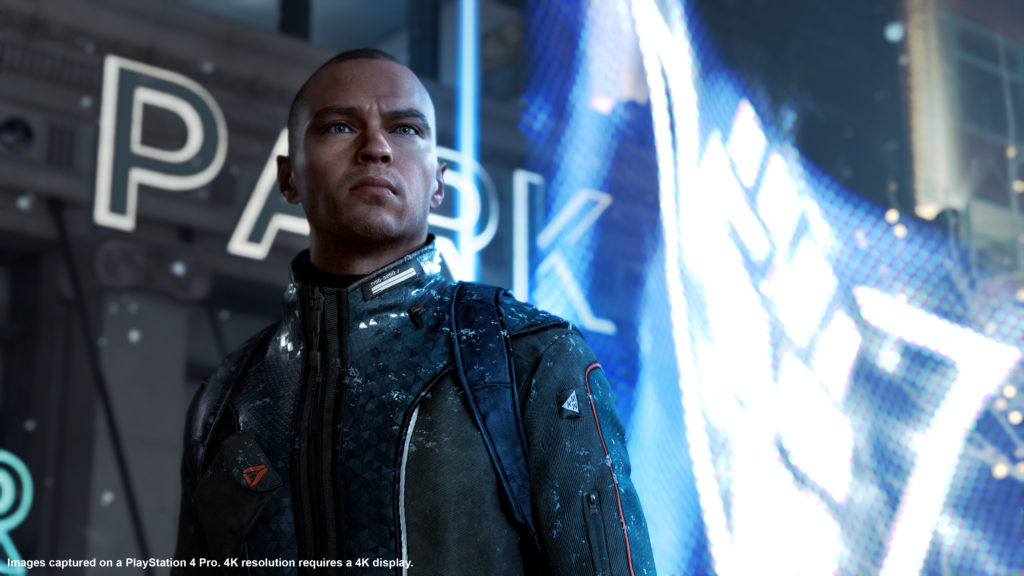
There are two issues here.
A Warehouse Inhabited By Boxes
The first is that androids are actually just things. They’re created to be slaves from day dot, they exist to serve humans.
The monsters aren’t the humans who keep these things in bondage. As far as timelines go, robots go from ‘happy to help’ and straight to ‘let my people go’ in the space of about two weeks.
Equating an armed force trying to stop the hairdryer from leading a revolution to the violent quelling of an enslaved people is on-the-nose at best. It’s reasonable to empathise with humans who haven’t yet adjusted to ‘my stovetop hates me’ in just seven days.
The real monsters are the people who coded these robots to feel. There’s not a single thing shown in the game that demonstrates why emotions are a necessary part of a robot’s existence. A wealthy old painter has a man-servant and chess partner — emotion not necessary. A poor, grumpy junkie has a nanny for a child he hates — emotion not necessary. A robot is created to hunt deviants — emotion not necessary.
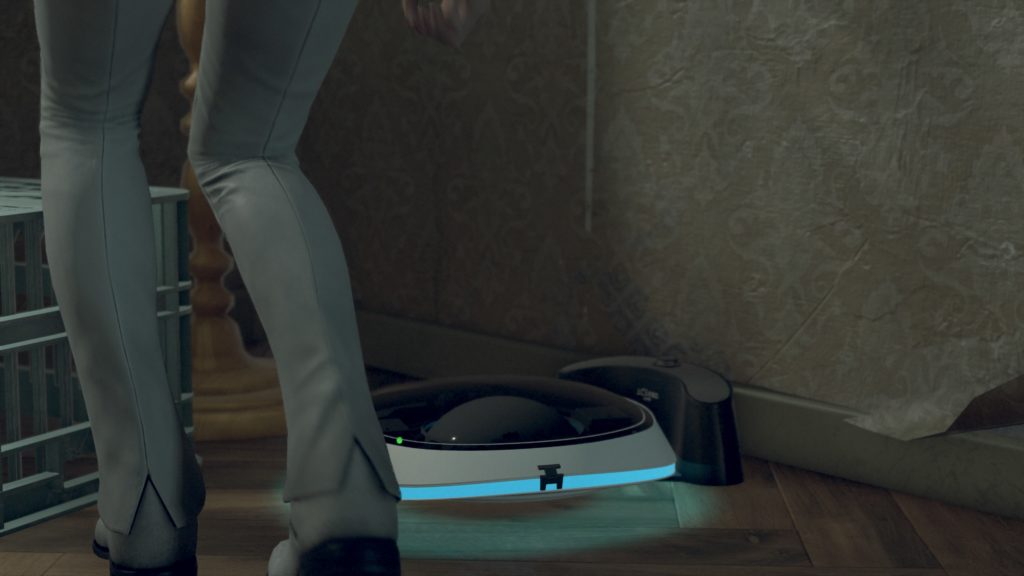
At one point, as Kara, you can actually activate a roomba to do some vacuuming. Is the robot vacuum a slave? It’s not like it can communicate its interests. Maybe it’s happy (or, best case scenario, indifferent) just vacuuming, but maybe it isn’t? Maybe Kara is as evil as her human oppressors. I guess we’ll never know (until Rumu 2: Electric Mop-up-Glue drops).
The Ghost in the Machine
The other problem with the narrative shortcut of ‘robots = slaves’ and ‘slaves = bad’ is that we don’t just play as robot rebels. Connor, the deviant hunter, is not a deviant himself. He actively hunts the other two player characters — Kara and Markus — and even interacts with them at times. This leads to a multi-pronged problem.
If we play as Connor, our goal is to capture deviants. Connor doesn’t exhibit any deviancy, so we generally shouldn’t stray from this goal. We’re punished and admonished as a player character for choosing actions outside of our mission parameters.
If I play the game making decisions for Connor based on my full understanding of the world, then I have knowledge beyond what Connor has — I know the androids are ‘alive’ and so it is in my interests to fail at catching them. This is ‘metagaming’, and it is bad.
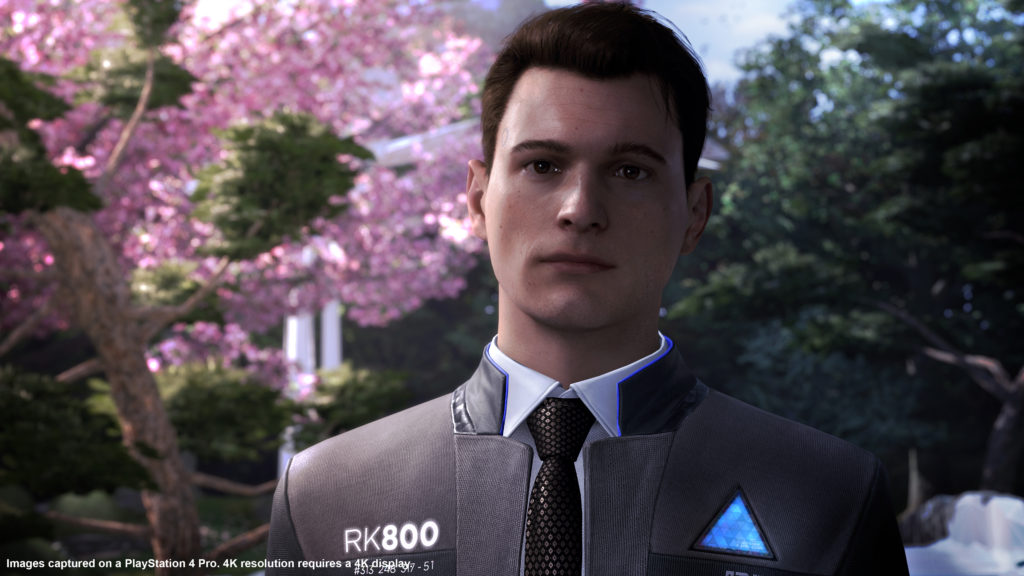
If I play to ‘win’, then when I am Connor hunting Markus or Kara it is in my interests to capture them. And when I am playing as the other two, it is in my interests to escape. I have conflicting goals here, which renders player choice moot — instead of playing the game based on my player character’s goals, I am making sometimes split second decisions based entirely on how I would like to see a scenario play out.
Whenever you succeed as Connor, you know you’re making things harder on yourself as Kara or Markus. I’d hate for it to go away — Connor is my favourite character in Detroit (after Lt Hank of course) — but it shouldn’t be in the game. The story is evenly split between all three characters, and it plays out chronologically so you’ll feel the impact of your decisions sometimes immediately.
Dramatic Irony
This leads me to the other massive problem I have with Detroit: Become Human. In it, I experience the triumph of breaking free of the bonds put in place by an oppressive creator while… remaining trapped in the bonds put in place by an oppressive creator. I realise up-front that Detroit is not an open world game. That it is a narrative experience, interactive fiction. But I cannot understand how they can make a game where I painfully break through my programming so I can walk up some stairs only to at other times be… just not able to walk up some stairs because it’s not narratively convenient.
It’d be another story if they played a short cutscene to call you back. “Hey Markus, we need to finish what we’re doing,” says one of your companions as you wander too close to the level’s boundaries. “Kara, there’s nothing upstairs,” says a creepy guy trying to beckon you down to his creepy-ass basement. In the world of film this is easy to manage, because Kara’s agency (or lack thereof, in a scene where she is living out a generic horror movie plotline) is scripted.
In games, the player is supposed to have that agency — the idea that the player is empowered with the ability to determine the game’s outcome is critical to all of Quantic Dream’s games. It’s a key element of a problem I’ve always had with Quantic Dream’s games — they exhibit the mere illusion of player choice, without any meaningful attempt at it.
The branching narrative tree — the Flowchart feature — is misdirection. It’s part of the trick, an attempt to get you to look left while they switch out a few things on the right. With the concept laid bare from the outset, it feels like you could start at A, head to B and then flip the script and shoot off to D on your way to Z. But in so many cases, you’re really just heading to Ci, or Cii, or Ciii. D always comes after C anyway, you’ve merely seen a slightly altered C.
In fact, presenting the narrative pathways might have been the worst possible move for Detroit. You earn points, for some reason, for the pathways you reach, and you can use context clues to work out what you need to do differently next time to unlock more (and reach a new high score!).
Worthless gamification aside, this transparency also hurts the illusion by showing exactly how all paths inevitably lead to a handful of the same places. Obviously there are significant differences in how the game can play out – not all paths lead to the same place — but on a smaller scale it feels less impactful. It reminds me of the quick time laden car scene from Heavy Rain, where you can fail many of the button prompts and still end up with the same outcome. You’re supposed to think each input is as critical as the last, but in reality there are only a few that really matter.
In Detroit I’m forced to do the same things I do in every Quantic Dream game. Convoluted button combinations to achieve meaningless tasks, quick time events with unknown failure states, awkward camera relative movement. There’s little evidence of growth here — to Quantic Dream, they nailed the interactive cinema concept the first time, and they don’t want to ruin a good thing with so-called ‘basic quality of life improvements’.
Press Play
The problem is that I never feel like I’m really doing anything important. Making me hold R2 and L2 and then pressing Triangle just feels like a needlessly complex way to press a ‘play’ button. Every action I make, except when I am explicitly making a choice, could be replaced with a triangle pointing to the right.
I’m reminded of the scene at the end of Metal Gear Solid 4 in these moments. Crawling through a microwave hallway, Snake and me feel the struggle together. I’m mashing a button, watching on-screen as my crew fights for their lives and Snake cooks. In MGS4, this scene is devastating in its effectiveness. You hammer just the one button, but you do it forever. Your forearm aches, your hand cramps, you’re tiring out. Snake’s situation is obviously worse — he’s 2 minutes into becoming a TV dinner — but player and player character endeavour together, and the moment is better for it.
MGS4 is how it feels when it is done well. Making me waggle my controller to pour a cup of coffee is as mundane as it sounds, and when I was a robot-slave the mundanity made sense. I actually like the idea that when I’m downtrodden and locked in, the mundane are my bread-and-butter. That while I’m still in indentured servo-tude (robot puns!), the things I painstakingly do are tedious for the player and monotonous for the player character. Link us up — then when I break free, even if you can’t free me from your on-rails ‘open’ narrative experience, at least never make me suffer through completing a boring task again. Hand that to the now ‘awake’ robot, subtly separating my game experience between slave and free.
But Detroit has you interacting at all times. And worst of all, it lacks consistency in that area as well. Everything is camera sensitive — that means you can’t ‘press X to move to a new hiding spot’ if you’re not looking at the correct area. It’s useful in some cases, but it’s ruinous in others. When you’re being chased, or you’re under fire, it’s hard to be able to look at everything around you to determine your best course of action in time, and annoying to then find the button prompt again after you’ve looked around.
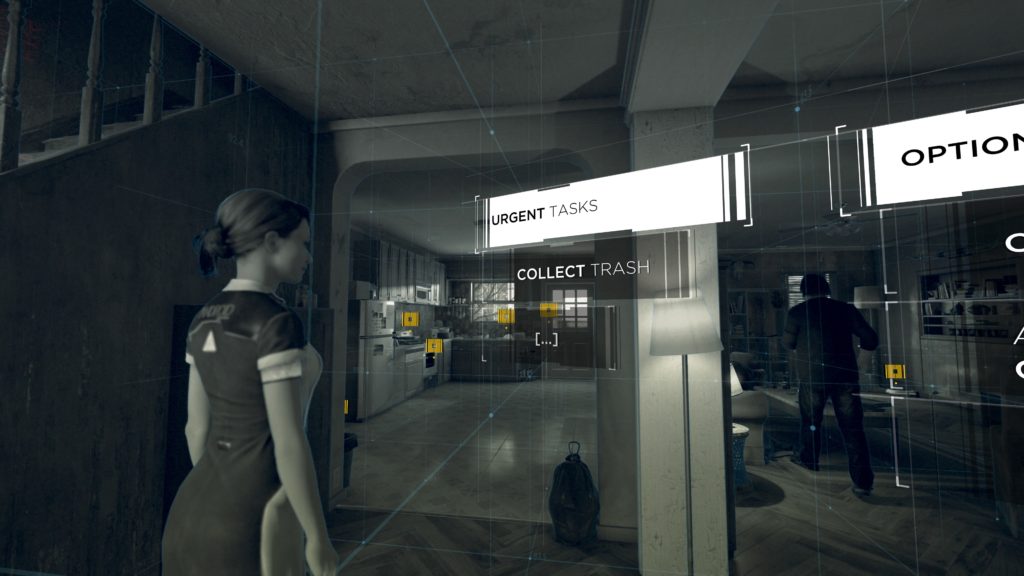
Detroit has a solution, sort of. With your mighty robot powers, you can hold R2 to pause time and scan the area to look at where you should go next — objectives are highlighted in yellow — but there are moments where this ability is not available. Time will still pause, but the yellow objective markers don’t appear, so you need to frantically run around the area to work out what you can interact with. It’s never explained why this feature disappears sometimes, but it’s usually when its absence increases the tension. How convenient.
Nitpickery
It seems like any time you’re on the brink of being immersed, Detroit finds a way to rip you out. Every character interaction you have is highlighted with a massive nameplate and an arrow pointing up or down indicating whether they like you more or less. Can’t I use context clues to work this out? The actors work so hard to convey subtle reactions with their faces, and the spectacular face-mapping technology does an amazing job of rendering their every wince perfectly — why is it spelled out for me?
Elsewhere, the attention to detail is just lacking. There are movie posters depicting what we’ll watch in the future, and you’ll see there are just 7 actors in the world of Detroit. Two movies share the same three actors, another two movies share another three, and the fifth film has just one actor — she mustn’t get along with the other six.
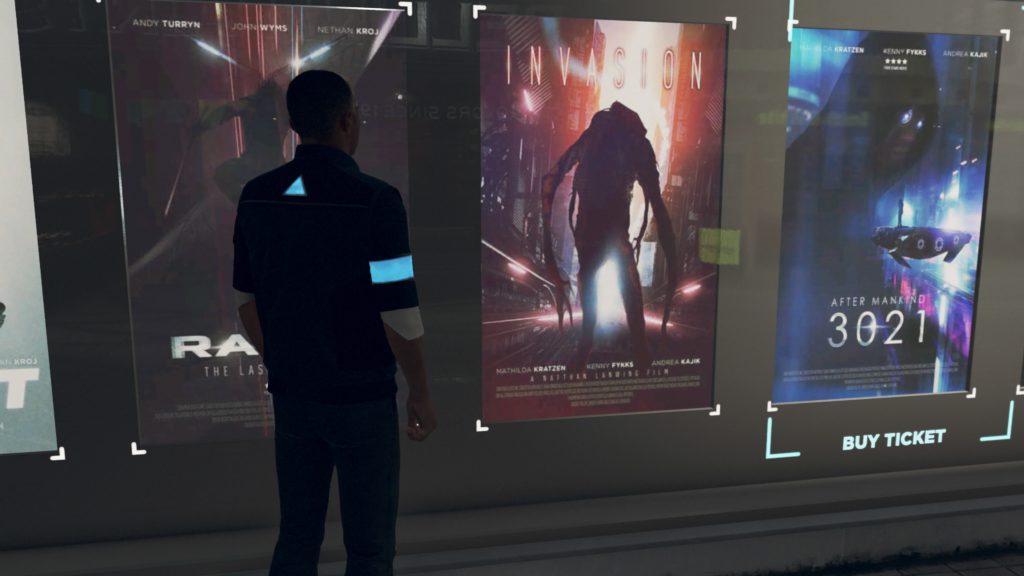
There are red explosive barrels everywhere in this world, as if the game was ripped from Call of Duty pre-production and dumped here. In an effort to make Clancy Brown seem more like a grizzled old detective, they have him driving a car that would have been an antique in 2018, let alone 20 years later. And then there’s futurism stuff that niggles at me — they’re still using plastic bags for rubbish, visiting paint stores to pick-up orders despite the fact that androids in autonomous vehicles could deliver online purchases all day. This is nitpickery, but it speaks to a specific lack of attentiveness. Barring some autonomous cars and some robots with critical design flaws, this might be set in 2018.
Maybe that’s on purpose, but why go to the trouble of pretending it’s the future then? If the link to present time is so critical to the overworn slavery parable, just set it in an alternate universe.
It’s Literally Got “Become Human” In The Name
I still can’t get over the slavery angle — it’s such an odd tack to take for an android story.
In other stories about synthetic life, the evolution of life is the focus. Blade Runner, Westworld, last year’s Nier: Automata — these explore what it means to be alive. That’s too passe for Detroit. ‘Did you know that Detroit was one of the critical final “stops” of the Underground Railroad?’ an android asks rhetorically should you linger on the main menu for too long. Thank you for underlining the concept, in case I missed the blatantly obvious connection while I steered Kara towards Canada and a life of freedom.
But again, if androids hadn’t needlessly been given the ability to feel emotions, there wouldn’t be an issue. And that itself is a pretty interesting topic that is never explored (or I never found the branching narrative path to let me explore it). How do you skip that? How do you decide to not explore what it means to be alive? To think and feel and be? How is it not at least a stepping stone on your journey towards freedom?
Obviously I shouldn’t dwell on the story they didn’t tell, but doesn’t it feel like it has been part of the game’s DNA from the start? The Kara tech demo they built Detroit: Become Human on was almost exclusively about Valorie Curry’s robot wanting to live. It was emotional and gripping, and a spectacular taste of what was to come — but six years later, we’re eating something completely different.
It’s not all bad. The acting is great, and it’s obvious Cage has grown tremendously as a Director. The tech itself is genuinely spectacular, and there are dozens of moments where Detroit looks utterly breathtaking — especially in 4K, checkerboarding or not. The soundtrack is great, conveying the mood perfectly in almost every situation. These things it does well make me wonder why David Cage insists on making games — his passion is so clearly in cinema. If Cage were to get a screenwriter and ditch the terrible burden of player agency (more than he already does) by making a film, I’m certain the results would be good. Detroit: Become Human, however, is not.

